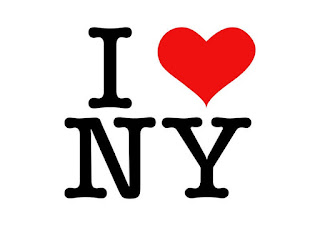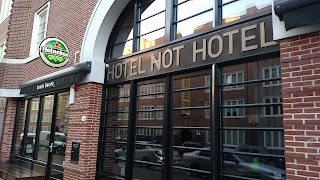Rembrandt and the Museum of Brands
When you think of New York, what comes to mind? Perhaps the ubiquitous logo adorning the world's t-shirts:
The graphic designer, Milton Glaser, came up with the logo idea while riding in the back of a taxi in 1976.
How about Texas? Do you know they had a PR and PSA coup with their intimidating warning: "Don't Mess with Texas." That slogan, created by the Texas Department of Transportation, not only gave Texas a bit of chutzpah on the national stage but it urged the state's litterbugs to rethink their habits. Studies found that the campaign helped reduce litter by 72% on Texas highways over a three-year-period. The warning soon took on a life of its own; it's basically become the state's unofficial motto. It soon became a rallying cry for the Texan people's grit and bravado.
While there is usually some type of strategic intent behind branding, there are some cities or states that fall into branding by accident. Boston, for instance, was long known for its sports teams, peculiar Irish inheritance, and density of colleges and universities. That all changed with Bostploitation and the spate of films based on the crime suspense novels of Dennis Lehane. (Not only did I meet him once in 1999 when I was working at the Braintree Barnes & Noble's but my godmother, Tricia, took a creative writing class with him.) Gone Baby Gone and Mystic River were two of his novels adapted into popular films. Other films in the Bostploitation genre include the seminal Good Will Hunting and The Town. These films made it seem like Boston was a thieving scoundrel with a heart of gold. With Bostploitation, you see a scene of some Irish mafia character summoning the Virgin Mary before robbing a bank. The only value worth having in these movies is loyalty. But as New Hampshire boy, Seth Myers, knows too well, it's often the sound of the locals that can give a city its identity.
https://www.youtube.com/watch?v=rLwbzGyC6t4
This type of tough boy image hasn't put a dent in Boston's international image. In fact, out of the six New England states, Massachusetts has had the highest population growth in the past ten years at a 5.4% increase, far outpacing the other five states in the region. For me, it's still home. You could say that everywhere is unique but Massachusetts is truly unique.
There are some places that shouldn't even try with even the idea of branding. South Dakota ran amok with their "Meth: We're on it" PSA campaign. While this was meant as a way to encourage South Dakotans to think about their community's ills, it quickly became a horrid and ill-conceived branding idea and an internet meme that sent social media aflutter.
-------
London has never had a problem with branding as it happily sits at the center of the universe. I never hear Londoners bemoan that their city is not like New York. I do however see a fascination, envy, and curiosity amongst my British friends over all things American. California, especially, puts a spell on the Brits that I've spoken with.
The beauty of London's branding is color-based: blood red against a charcoal beige background with a mix of rainy Monday grey. All of its seminal images have that shade of pure blood red: the telephone booths, the double-decker buses and the famous royal guards. For neutrals, you can find your stately grey Tower Bridge replicas and the neutral Gothic edifices holding Big Ben and the UK's Parliament.
So while Londinium has long had a certain palette and aesthetic, it was never a believer in brands. London does, however, have a whole museum devoted to brands: the exhibition, study and criticism of branding. In West London is the Museum of Brands, a place where all forms of ephemera is on display in the "time tunnel" - everything from Victorian cigarette boxes to boy-band One Direction lunchboxes circa 2010. Taking photos of the items is strictly prohibited but I did manage to capture a poetic photo of the exterior. The main exhibition is the life's work of museum founder, Robert Opie; over twelve thousand items splendidly curated.
At first, to be honest, I was a bit skeptical of branding, seeing as how it has such a powerful link with fascist history. But, Mauricio, in so many words, encouraged me to look at branding in a more agnostic way. For everything we do and everything we are has an element of branding. It's a part of capitalist culture. I'm much more geared towards text and literature but the interesting thing about the Museum of Brands is they take a progressive, critical eye towards the idea of branding. Several times a month they hold workshops, lectures and exhibitions for school groups, families and trade groups. One coming up in July, for interested adults, is entitled Is Your Brand Queer Enough?
Robert Opie's twelve thousand items is not the only display in town, however. A much smaller, more intimate collection can be seen through February 2nd at a village venue south of the Thames, the Dulwich Picture Gallery. "Rembrandt's Light" was a fantastic Saturday day-trip exhibition. Branding existed in Rembrandt's heyday (Holland in the 17th century), but it had likely more to do with flags and royal colours and coats of arms. Rembrandt's use of light in his painting technique was not a brand or even a signature but something more substantial: the theme or central narrative of each of his paintings, all of which seemed to tell a story from the New Testament.
https://en.wikipedia.org/wiki/I_Love_New_York
https://en.wikipedia.org/wiki/Don%27t_Mess_with_Texas
https://en.wikipedia.org/wiki/Dennis_Lehane
https://www.brookings.edu/research/population-change-and-the-projected-change-in-congressional-representation/
https://www.theguardian.com/us-news/2019/nov/18/south-dakota-meth-were-on-it-addiction-campaign
https://en.wikipedia.org/wiki/Londinium
https://www.museumofbrands.com/
https://www.dulwichpicturegallery.org.uk/whats-on/exhibitions/2019/october/rembrandts-light/
The graphic designer, Milton Glaser, came up with the logo idea while riding in the back of a taxi in 1976.
How about Texas? Do you know they had a PR and PSA coup with their intimidating warning: "Don't Mess with Texas." That slogan, created by the Texas Department of Transportation, not only gave Texas a bit of chutzpah on the national stage but it urged the state's litterbugs to rethink their habits. Studies found that the campaign helped reduce litter by 72% on Texas highways over a three-year-period. The warning soon took on a life of its own; it's basically become the state's unofficial motto. It soon became a rallying cry for the Texan people's grit and bravado.
"Don't Mess with Texas T-Shirt" by J. Stephen Conn is licensed under CC BY-NC 2.0
While there is usually some type of strategic intent behind branding, there are some cities or states that fall into branding by accident. Boston, for instance, was long known for its sports teams, peculiar Irish inheritance, and density of colleges and universities. That all changed with Bostploitation and the spate of films based on the crime suspense novels of Dennis Lehane. (Not only did I meet him once in 1999 when I was working at the Braintree Barnes & Noble's but my godmother, Tricia, took a creative writing class with him.) Gone Baby Gone and Mystic River were two of his novels adapted into popular films. Other films in the Bostploitation genre include the seminal Good Will Hunting and The Town. These films made it seem like Boston was a thieving scoundrel with a heart of gold. With Bostploitation, you see a scene of some Irish mafia character summoning the Virgin Mary before robbing a bank. The only value worth having in these movies is loyalty. But as New Hampshire boy, Seth Myers, knows too well, it's often the sound of the locals that can give a city its identity.
https://www.youtube.com/watch?v=rLwbzGyC6t4
This type of tough boy image hasn't put a dent in Boston's international image. In fact, out of the six New England states, Massachusetts has had the highest population growth in the past ten years at a 5.4% increase, far outpacing the other five states in the region. For me, it's still home. You could say that everywhere is unique but Massachusetts is truly unique.
"CZM_BostonHarborwalk_BR" by Massachusetts Office of Coastal Zone Management is licensed under CC BY-NC-SA 2.0
There are some places that shouldn't even try with even the idea of branding. South Dakota ran amok with their "Meth: We're on it" PSA campaign. While this was meant as a way to encourage South Dakotans to think about their community's ills, it quickly became a horrid and ill-conceived branding idea and an internet meme that sent social media aflutter.
-------
London has never had a problem with branding as it happily sits at the center of the universe. I never hear Londoners bemoan that their city is not like New York. I do however see a fascination, envy, and curiosity amongst my British friends over all things American. California, especially, puts a spell on the Brits that I've spoken with.
Fruit & Veg Garden @ Kilburn Station Platform
Jubilee Line
The beauty of London's branding is color-based: blood red against a charcoal beige background with a mix of rainy Monday grey. All of its seminal images have that shade of pure blood red: the telephone booths, the double-decker buses and the famous royal guards. For neutrals, you can find your stately grey Tower Bridge replicas and the neutral Gothic edifices holding Big Ben and the UK's Parliament.
"Byng Place" by Dun.can is licensed under CC BY 2.0 

So while Londinium has long had a certain palette and aesthetic, it was never a believer in brands. London does, however, have a whole museum devoted to brands: the exhibition, study and criticism of branding. In West London is the Museum of Brands, a place where all forms of ephemera is on display in the "time tunnel" - everything from Victorian cigarette boxes to boy-band One Direction lunchboxes circa 2010. Taking photos of the items is strictly prohibited but I did manage to capture a poetic photo of the exterior. The main exhibition is the life's work of museum founder, Robert Opie; over twelve thousand items splendidly curated.
At first, to be honest, I was a bit skeptical of branding, seeing as how it has such a powerful link with fascist history. But, Mauricio, in so many words, encouraged me to look at branding in a more agnostic way. For everything we do and everything we are has an element of branding. It's a part of capitalist culture. I'm much more geared towards text and literature but the interesting thing about the Museum of Brands is they take a progressive, critical eye towards the idea of branding. Several times a month they hold workshops, lectures and exhibitions for school groups, families and trade groups. One coming up in July, for interested adults, is entitled Is Your Brand Queer Enough?
Robert Opie's twelve thousand items is not the only display in town, however. A much smaller, more intimate collection can be seen through February 2nd at a village venue south of the Thames, the Dulwich Picture Gallery. "Rembrandt's Light" was a fantastic Saturday day-trip exhibition. Branding existed in Rembrandt's heyday (Holland in the 17th century), but it had likely more to do with flags and royal colours and coats of arms. Rembrandt's use of light in his painting technique was not a brand or even a signature but something more substantial: the theme or central narrative of each of his paintings, all of which seemed to tell a story from the New Testament.
Most people would not peg me as a churchgoer and although I celebrate my pagan roots, I cannot escape my Catholic upbringing, at times I embrace it. In the permanent main gallery, there is even a famous painting of my "confirmation" name saint, Sebastian, in all his suffering.
Rembrandt brings me closer to my dormant faith as do Christian-Secular-Crossover artists like Al Green and Lauryn Hill, even the openly-Catholic, witty comedian, Stephen Colbert. Religious or not, there is only a few days left to see the Rembrandt's exhibition before it closes on the 2nd of February. You can then find out for yourself not only if Rembrandt had a brand in mind or if he was driven by something deeper.
As for London, its brand can't be condensed into a pithy slogan - although there are a slew of quotes that try to do it justice. I feel that in living here, the whole world is just a tube ride away. It can rely on the strength of its resources and its centuries of innovation.
------
References
https://en.wikipedia.org/wiki/I_Love_New_York
https://en.wikipedia.org/wiki/Don%27t_Mess_with_Texas
https://en.wikipedia.org/wiki/Dennis_Lehane
https://www.brookings.edu/research/population-change-and-the-projected-change-in-congressional-representation/
https://www.theguardian.com/us-news/2019/nov/18/south-dakota-meth-were-on-it-addiction-campaign
https://en.wikipedia.org/wiki/Londinium
https://www.museumofbrands.com/
https://www.dulwichpicturegallery.org.uk/whats-on/exhibitions/2019/october/rembrandts-light/
















Comments
Post a Comment